|
TRANSLATE THIS ARTICLE
Integral World: Exploring Theories of Everything
An independent forum for a critical discussion of the integral philosophy of Ken Wilber
 Keith McCaughin retired in 2012 after more than 40 years in business and technical management and consulting. He specialized in Strategic Planning, Enterprise Architecture and Business Process Improvement and Reengineering. He has collaborated with John Zachman and Steven Spewak to promote Enterprise Architecture as a bridge between business and technology communities. His consulting work focused on Fortune 100 companies and Federal Government Agencies. His clients included Chase Manhattan Bank, NBC, Metropolitan Life, New York Life, and DuPont in the commercial arena and Federal Departments of Defense, Veterans Affairs, Labor, and Agriculture. Keith McCaughin retired in 2012 after more than 40 years in business and technical management and consulting. He specialized in Strategic Planning, Enterprise Architecture and Business Process Improvement and Reengineering. He has collaborated with John Zachman and Steven Spewak to promote Enterprise Architecture as a bridge between business and technology communities. His consulting work focused on Fortune 100 companies and Federal Government Agencies. His clients included Chase Manhattan Bank, NBC, Metropolitan Life, New York Life, and DuPont in the commercial arena and Federal Departments of Defense, Veterans Affairs, Labor, and Agriculture.
Integral PoliticsBased on Systems Thinking and AQALKeith McCaughinContents
Introduction
Is America an oligarchy or a democracy? The truth is America is neither oligarchy nor democracy. It is both.
Is America an oligarchy or a democracy? A recent research paper suggests, but never says, that America appears to be moving toward an oligarchy influenced by affluent individuals and business with little or no influence from the rest of us.[1] Both the Democratic and Republican parties praise democracy. The truth is America is neither oligarchy nor democracy. It is both. The evolution of society and politics is and always has been a spirally developing hierarchical network appropriate to the dominant spiral developmental stage of each society. Dictatorships were always rule by few, never one; and democracies were always rule by many, never all. Always there are varying degrees of both oligarchy and democracy. Both developed together in spiral dynamics within fitness limits between varying degrees of hierarchy and network modules. Societies and their political systems are not moving from hierarchical oligarchy to modular democracy as an end state. They are always transcending, rising above and including prior stages of development into hierarchical modularity or regressing, falling below or excluding prior stages. 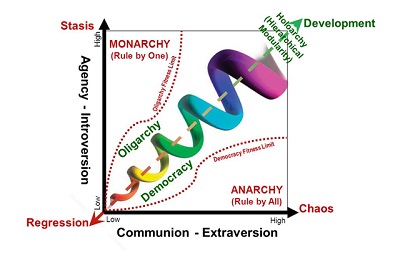 The diagram above illustrates that rule by one, monarchy, and rule by all, anarchy, are extremes of political systems that never survived if they ever existed. Instead of one person rule there is oligarchy, rule by a few elites, which is within the upper fitness limit. Instead of rule by all, anarchy, there is democracy, rule by many, which is within the lower fitness limit. The spiral development curve shows that oligarchies and democracies develop simultaneously moving back and forth from one dominant form to the other over time. Abnormal, pathologic, regression led to the extinction of many political systems in excessive liberty, chaos, or excessive tyranny, stasis. History confirms this. Agency and Communion are tendencies of holoarchies and can vary independently yielding four basic probabilities:
Agency and communion involve interactions of holons with other holons, and the holarchical relationship between the two holons determines the nature of the interaction. A holon expresses agency when it interacts with a lower holon, and communion when it interacts with a holon on the same or a higher level (more accurately, in my model, a higher stage). Thus we act agentically in respect to inanimate matter or lower forms of life, and communally with respect to other people. Likewise, a society acts agentically with respect to its individual members, and communally with respect to other societies. This understanding assumes that societies are in fact higher than their individual members, and as I will discuss later, is in fact another reason for adopting this view. We need this understanding of the relationship of societies to their members in order to have a coherent view of agency and communion.[2] Introversion and Extraversion are tendencies of human developmental stages can vary independently yielding four basic probabilities:
“What's really remarkable about introversion-extraversion is how universally it affects a person's talents and choices. A person could possess 'exactly' the same intelligence profile in all other areas, and yet lead an almost completely different life, if only he found himself an extreme introvert as opposed to an extreme extravert. For example, I would rank comedian Daniel Tosh to be as brilliant as philosopher Ken Wilber. Yet it's simply impossible to imagine either of them doing what the other does—the thought wouldn't even cross anybody's mind under ordinary circumstances. Our society has not yet embraced this fundamental difference between the types along this scale, to our extreme detriment, I think, because even the basic programs by which young people are educated should be informed by this absolutely crucial distinction.”[3] Pure Monarchy or Anarchy cannot exist for long, if they ever really existed at all. All monarchies had selected elites (oligarchs) who enforced their rule. All anarchies had at least a minimum of (s)elected representatives who theoretically enforced the will of all. Pure Monarchy or Anarchy is extinct. “Stromberg correctly notes that absolute democracy has never existed, nor is it an end in itself. It has been most successful when the traditional and modern, the organic and the plural, are in rough balance. In this lies both the secret of its transitional nature and the secret of its adaptability. While it is not certain that it will dominate the politics of the future, certain of its features are likely to inform the future for a long time to come.”[4] Oligarchy and Democracy are universal tendencies of political systems and can vary independently yielding an infinite gradation through all AQAL Stages of Development indicated by the corresponding color of the spiral (Spiral Dynamics) moving back and forth between dominant oligarchy and dominant democracy, between dominant agency and dominant communion, and between dominant introversion and dominant extroversion. Development evolves upward and to the right by transcending, rising above and including healthy prior stages and negating pathologies of prior stages. Regression devolves downward and to the left by failing to transcend, falling into pathology, failing to include healthy prior stages, or failing to negate pathologies of prior stages. Systems Thinking Approach to Integral PoliticsSocial change takes place within the context of a political system with multi-dimensional tendencies toward oligarchy and democracy. “Social change is the result of an interacting network of various social tendencies, and relationships of many different kinds. There seems to be no single 'leading factor' which is always in the forefront and the relationship cannot always be reduced to a simple dichotomy - of either conflict or cooperation. In a given system, interactions between opposing tendencies can take many forms including: conflict, competition, cooperation and collaboration, which may coexist simultaneously. Actors in a social system may cooperate with regard to one pair of tendencies, compete over others, and be in conflict with respect to different sets at the same time.”[5] Gharajedaghi contends that “the continued treatment of multidimensional realities as uni-dimensional concepts - simple dichotomies or continua - is not only at the core of the confusion and dilemmas, but also represents a fallacy into which many people of good will often fall. The point is that sets of opposing tendencies - assumed to be the prime producers of change - are, in fact, two sides of the same coin; they coexist and interact continuously.” The complex interaction between the opposing tendencies of oligarchy and democracy is not a simple one-or-the-other, it is both in an AND relationship. “In viewing AND/OR relations in the context of social dynamics, we are concerned with processes, not states. We are dealing with opposing tendencies, not opposing states.” Firstly, there is the conceptualization of conflicting tendencies as two mutually exclusive, discrete entities. Here conflicts are treated as dichotomies which are usually expressed as 'X' or 'NX'. This represents an 'OR' relationship (this is not an inclusive OR but an exclusive OR (XOR), and thus a win/lose struggle which calls for a solution of the conflict. The loser is usually declared wrong and eliminated.  Secondly, there are uni-dimensional conceptions of conflict situations. Here conflicting positions are formulated in such a way that they can be represented by a continuum. Here there seem to be many shades of gray between black and white. This calls for compromise or resolution of the conflict.  A compromise is therefore a mixture of ideas of both poles of tension. It might seem to be a kind of integration, but this is usually quite superficial. It usually contains elements of the two extremes but it does not provide a new framework that can encompass both poles. Thirdly there are multidimensional conceptions of conflict, in which interaction between opposing tendencies is characterized by an 'AND' relationship. In contrast to 'OR', the 'AND' relationship recognizes the mutual interdependence of opposing tendencies. In this conception, the opposing tendencies not only coexist and interact, but also form a complementary relationship. A complement is that which fills out or completes a whole. 'Complementarity' is not a logical concept, nor is it the notion of the whole. The complementarities are not necessarily a pair. 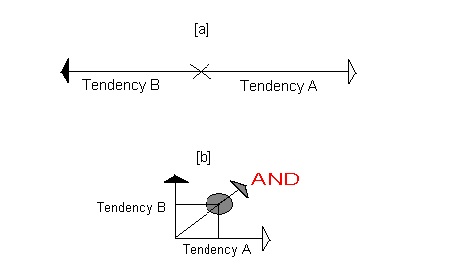 In a flexible social system, oscillations of lower amplitude occur without disruption within the critical cultural boundaries, as periodic shifts in governments, e.g. between Labour and Conservative parties in the UK, or Democrats and Republicans in the US, demonstrate. But in a polarized society, if a rigid orientation tries to cross the critical cultural line, a violent and destructive reaction will move it back to the other extreme, producing further frustration and greater oscillations, and, finally, cusping into a change of phase. Retrieval from such a situation is then extremely problematic, and the relationship between members is irreparably damaged as happens in societies which are thrown into a perpetual state of civil disorder as shown below. 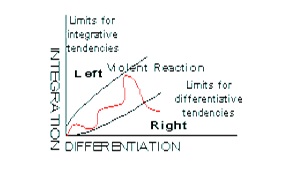 Therefore, corresponding to every level of differentiation, there exists a minimum required level of integration below which a system would disintegrate into chaos. Conversely, higher levels of integration require higher degrees of differentiation in order to avoid oppression. This leads to the conclusion that the periodic oscillations and disruptions witnessed in a social system are basically produced by dichotomous treatment of dialectical realities. Here then is the genesis of the main diagram in this paper (repeated below): 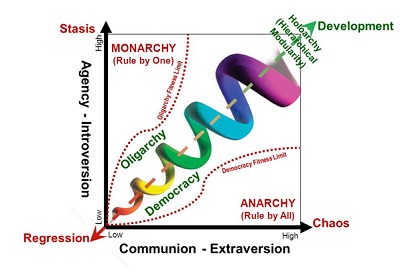 The Problem of Two-Party SystemsAs of December 2013, a Gallup poll reported party affiliation as 24% Republican and 30% Democrat. Although they reported 44% independent, this is very misleading because independents are not a political party. Independents do not affiliate with any political party. The 54% of party affiliated voters perpetuate the two-party system that tyrannizes the minority of independents. The two-party majority of Democrats and Republicans tell us we live in a democracy. Many in the independent minority realize that they use this lie to subvert our Republic, an amalgam of oligarchy and democracy. The two-parties have insidiously established a permanent warring political class of Democrats and Republicans that preaches majority rule that inevitably leads to the tyranny of the majority. The Founding Fathers warned us about the threat from a two-party system. We are now suffering under the consequences of the parties' corruption. John Adams said: “There is nothing which I dread so much as a division of the republic into two great parties, each arranged under its leader, and concerting measures in opposition to each other. This, in my humble apprehension, is to be dreaded as the greatest political evil under our Constitution.” George Washington agreed, saying in his farewell presidential speech: “The alternate domination of one faction over another, sharpened by the spirit of revenge, natural to party dissension, which in different ages and countries has perpetrated the most horrid enormities, is itself a frightful despotism. But this leads at length to a more formal and permanent despotism. The disorders and miseries, which result, gradually incline the minds of men to seek security and repose in the absolute power of an individual; and sooner or later the chief of some prevailing faction, more able or more fortunate than his competitors, turns this disposition to the purposes of his own elevation, on the ruins of Public Liberty The Problem of Political CompromiseHow can we sensibly address the conflict created by the two-party system? First, we must realize that compromise, advocated by both parties, is a cynical strategy to maintain and even heighten conflict. A model[7] of different approaches to address conflict shows us how compromise maintains conflict. The model describes four approaches with respective outcomes. Compromise is addressed in 3. Resolve:
Second, we must:
Elaboration of the Main Diagram from Emerging TheoriesA set of interdependent variables forms a circular relationship. Each variable coproduces the others and, in turn, is coproduced by the others. Which one comes first is irrelevant because none can exist without the others. This phenomenon is found among any pair of interdependent variables such as integration and differentiation. Without an effective differentiation there can never be a meaningful integration.[8] 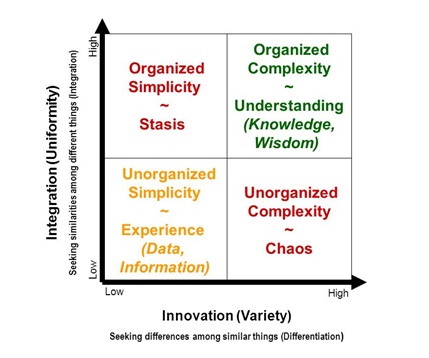 In its very basic form, we discover that organized simplicity (upper left quadrant) leads to stasis. What is the point and who cares? It's still just uninteresting noise. Unorganized complexity (lower right quadrant) is the reverse. It is too exciting and cannot be understood. It too is just noise. But unorganized simplicity (lower left quadrant) yields experiential data and information. According Russell Ackoff the elements of understanding are arranged in a hierarchy from data, perceived facts, to information, interpreted data, to knowledge, evaluated information, and wisdom, assimilated knowledge. Therefore, the experience of data and information supports the knowledge and wisdom of organized complexity, the result of development.[9][10] Power law of Extinction in Complex SystemsBiological evolution balances uniformity and variety in a process called recombination. Extinctions of species tend to follow a power law: a few large extinctions of extreme uniformity and many small extinctions of extreme variety. Stress levels on species go up as the balance between uniformity and variety is skewed in either direction, until eventually they exceed their tolerance level and become extinct. We call this a fitness limit.[11] Gharajedaghi[12] has observed this same phenomenon in organizations and governments. Complex system designs must be shaped by the management and engineering processes to avoid having so much variety, communion, that they become chaotic or having so much uniformity, agency, that they become static. We also know from Barabasi[13] et al that a few large extinctions occur at the extremes of the high/low integration axis and the low/high differentiation axis. The log of these extinctions produces a -1 curve or a straight line across the diagram bisecting the diagram from High to high. 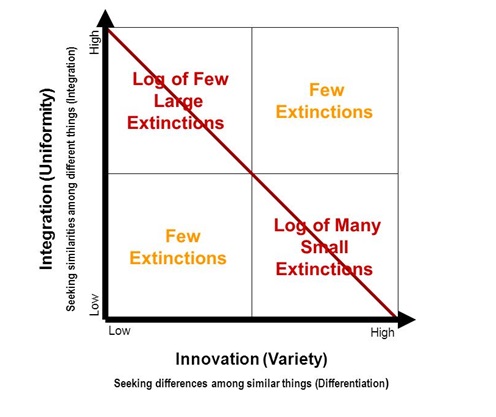 Fitness Limits of Complex SystemsOrmerod[14] describes fitness limits that run approximately parallel to the time line. Beyond these fitness limits, extinctions are highly likely. I think the limits may be somewhere around three standard deviations from the norm. 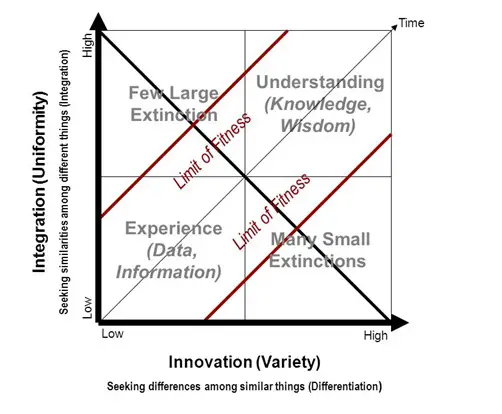 Effects of Youth and AgeStart Up "The probability of failure, or extinction, is known to be highest when the company is first formed. It then falls away rapidly. After a short time , just two or three years, the probability of failure in any period of time is then unrelated to the age of the firm." Old Age "Soon, however, the value of more experience falls to zero. No matter how long the firm has survived, beyond the initial danger period the probability of failure in the immediate year ahead is virtually the same."[16] Normal development S-Curve The S-shaped curve of development seems to be consistent with this model. 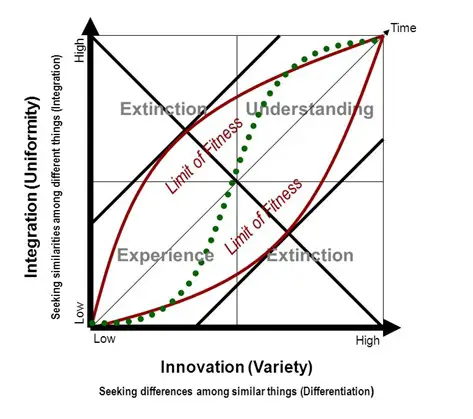 Impact of Strategy on Fitness“Once we allow the agents in the theoretical model to update their strategies with reasonable regularity, external shocks alone cannot generate the key features of firm extinctions which we observe. In particular, the relationship between the size and frequency of extinction events no longer emerges from the interplay between changes in the external stress levels and the stress tolerance levels of the individual agents.” “There are very considerable returns to acquiring knowledge, for even a small amount leads to a sharp increase in the average age of agents at extinction. Indeed we find that as both the amount of knowledge available to agents increases and as the number of agents capable of acquiring such knowledge rises, their life span begins to approach the limiting, full-information paradigm of conventional economic theory in which agents live forever. So if we can acquire knowledge about the impact of strategy, it is distinctly valuable.”[18] 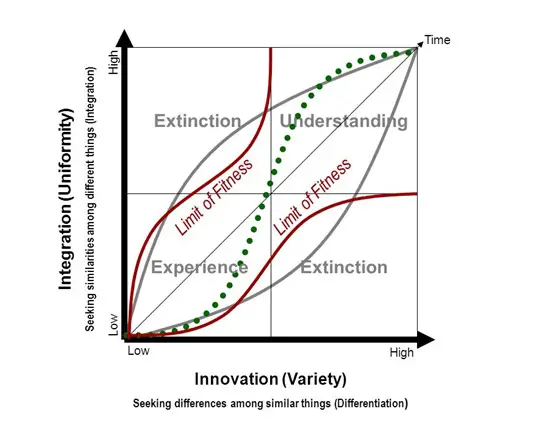 Here then is the full development of the basic diagram based on additional theories that leads back to the main diagram and AQAL development stages embedded between the fitness limits of complex adaptive systems (repeated below): 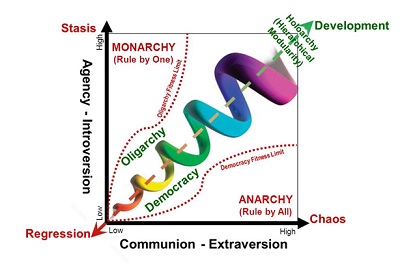 The AQAL Approach to Integral PoliticsKen Wilber's[19] analysis of the problems of integral politics is definitive. Therefore, I will quote him at length. Ken's thoughts relate to the development spiral embedded between the fitness limits of complex adaptive systems in the diagram above. Ken's conservative relates to the oligarchy side of the spiral and liberal relates to the democracy side of the spiral. The traditional conservative ideology is rooted in a conventional, mythic-membership, sociocentric wave of development. Its values tend to be grounded in a mythic religious orientation (such as the Bible); it usually emphasizes family values and patriotism; it is strongly sociocentric (and therefore often ethnocentric); with roots as well in aristocratic and hierarchical social values and a tendency toward patriarchy and militarism. This type of mythic membership and civic virtue dominated cultural consciousness from approximately 1,000 BCE to the Enlightenment in the West, whereupon a fundamentally new average mode of consciousness—the rational-egoic—emerged on an influential scale, bringing with it a new mode of political ideology, namely, liberalism. The liberal Enlightenment understood itself to be in large measure a reaction against the mythic-membership structure and its fundamentalism, in two aspects especially: the socially oppressive power of myths with their ethnocentric prejudices (e.g., all Christians are saved, all heathens go to hell), and the nonscientific nature of the knowledge claimed by myths (e.g., the universe was created in six days). Both the active oppression instituted by mythic/ethnocentric religion and its nonscientific character were responsible for untold suffering, and the Enlightenment had as one of its goals the alleviation of this suffering. Voltaire's battle cry—which set the tone of the French Enlightenment—was "Remember the cruelties!"—the suffering inflicted by the Church on millions of people in the name of a mythic God. In place of an ethnocentric mythic-membership, based on a role identity in a hierarchy of other role identities, the Enlightenment sought an ego identity free from ethnocentric bias (the universal rights of man) and based on rational and scientific inquiry. Universal rights would fight slavery, democracy would fight monarchy, the autonomous ego would fight the herd mentality, and science would fight myth: this is how the Enlightenment understood itself (and in many cases, rightly so). In other words, at its best the liberal Enlightenment represented—and was a product of—the evolution of consciousness from conventional/ sociocentric to postconventional/worldcentric. Now had liberalism been just that—the product of an evolutionary advance from ethnocentric to worldcentric—it would have won the day, pure and simple. But, in fact, liberalism arose in a climate that I have called flatland. Flatland—or scientific materialism—is the belief that only matter (or matter/energy) is real, and that only narrow science has any claim to truth. (Narrow science, recall, is the science of any Right-Hand domain, whether that be atomistic science of the Upper Right, or systems science of the Lower Right.) Flatland, in other words, is the belief that only the Right-Hand quadrants are real. And liberalism, arising directly in the midst of this scientific materialism, swallowed its ideology hook, line, and sinker. In other words, liberalism became the political champion of flatland. The only thing that is ultimately real is the Right-Hand, material, sensorimotor world; the mind itself is just a tabula rasa, a blank slate that is filled with representations of the Right-Hand world; if the subjective realm is ill, it is because objective social institutions are ill; the best way to free men and women is therefore to offer them material-economic freedom; thus scientific materialism and economic equality are the major routes of ending human suffering. The interior realms—the entire Left-Hand domains—are simply ignored or even denied. All interiors are equal, and that ends that discussion. But this desire to alleviate human suffering is applied universally—all people are to be treated fairly, regardless of race, color, sex, or creed (the move from ethnocentric to worldcentric). Thus, liberal political theory was coming from a higher level of development, but a development that was caught in pathological flatland. Put bluntly, liberalism was a sick version of a higher level. That is the great irony of liberalism. Theorists have long agreed that traditional liberalism is inherently self-contradictory, because it champions equality and freedom, and you can have one or the other of those, not both. I would put this contradiction as follows: Liberalism is itself the product of a whole series of interior stages of consciousness development—from egocentric to ethnocentric to worldcentric—whereupon it turned around and denied the importance or even the existence of those interior levels of development! Liberalism, in championing only objective causation (i.e., flatland), denied the interior path that produced liberalism. The liberal stance itself is the product of stages that it then denies—and there is the inherent contradiction of liberalism. Liberalism thus refused to make any "judgments" about the interiors of individuals—no stance is better than another!—and instead focused merely on finding ways to fix the exterior, economic, social institutions, and thus it completely abandoned the interiors (values, meanings, interior development) to the conservatives. The conservatives, on the other hand, fully embraced interior development—but only up to the mythic-membership stage, which is nonetheless healthy as far as it goes: a healthy version of a lower level. (Mythic-membership, civic virtue, the blue meme, the conventional/conformist stage of development—these are all normal, healthy, natural, necessary stages of human development, and this sturdy social structure is still the main base of traditional conservative politics.) So here is the truly odd political choice that we are given today: a sick version of a higher level versus a healthy version of a lower level—liberalism versus conservatism. The point is that a truly integrated Third Way would embrace a healthy version of the higher level—namely, rooted in the postconventional/ worldcentric waves of development, it would equally encourage both interior development and exterior development—the growth and development of consciousness and subjective wellbeing, as well as the growth and development of economic and material wellbeing. It would be, in other words, "all-level, all-quadrant." Moreover, from this spacious vantage point, the prime directive of a genuine Third Way would be, not to try to get everybody to a particular level of consciousness (integral, pluralistic, liberal, or whatever), but to insure the health of the entire spiral of development at all of its levels and waves. (The nature and importance of the prime directive is explored in the Introduction to Volume Seven of the Collected Works.) Thus the two steps toward a truly integral Third Way are: (1) uniting subjective and objective, and (2) seeing stages of the subjective and thus arriving at the prime directive. The Problem of BusinessThe problem of business is a hangover from Feudalism[20]
The British, French and Dutch introduced feudalism to colonial America but it did not last long. However, vestiges of feudalism continued to infect political, economic, and social systems. Since the 1960s Neo-feudalism and a contrasting stakeholder theory have emerged in corporations. Feudalism and neo-feudalism can be compared favorably to the concept of the corporation with a purpose to maximize profits for its shareholders. Feudalism and neo-feudalism can be contrasted with a more socially conscience organizing principle of stakeholder theory that optimizes value for all stakeholders. The outcome remains to be seen. If this complex system called a corporation and its containing political, economic and social systems adapt as we would expect from Complex Adaptive Systems (CAS) theory, they may merge in dynamic tension or be transcended in a hybrid theory and practice as suggested by AQAL. 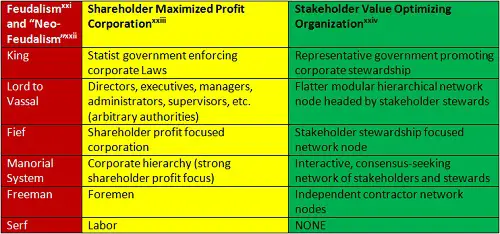
Relationships among Feudalism, Profit Maximizing, and Stakeholder Value Optimizing Organizations
According to Russell Ackoff the purpose of a corporation is not to maximize profit for shareholders but to maximize value for all stakeholders, which includes shareholders. Profit is necessary but insufficient to purpose. It is like saying the purpose of a person is to breathe. Stakeholder theory is a theory of organizational management and business ethics that addresses morals and values in managing an organization. It was originally detailed by R. Edward Freeman in the book Strategic Management: A Stakeholder Approach, and identifies and models the groups which are stakeholders of a corporation, and both describes and recommends methods by which management can give due regard to the interests of those groups. In the traditional view of the firm, the shareholder view, the shareholders or stockholders are the owners of the company, and the firm has a binding fiduciary duty to put their needs first, to increase value for them. However, stakeholder theory argues that there are other parties involved, including governmental bodies, political groups, trade associations, trade unions, communities, financiers, suppliers, employees, and customers. Sometimes even competitors are counted as stakeholders - their status being derived from their capacity to affect the firm and its other morally legitimate stakeholders. According to H. Jeff Smith:[25] U.S. executives and board members might reasonably ask what they should do differently. First, executives should consider changing their language, getting rid of the phrase “maximizing shareholder value.” Indeed, many of the most ardent supporters of the shareholder theory have quietly shifted to “maximizing our company's value” and other similar phrases. An even more temperate phrasing of the corporate objective would be “maximizing our company's contribution to our economic system.” Second, executives should feel freer to change their attitudes and behaviors openly. If a CEO or board member's only reason for not verbalizing a belief in the stakeholder theory was a fear of takeover, it is likely that such pressures will abate given the increasing evidence that the “market discipline” of takeovers during the last few years has proven less than efficient in maximizing returns. Assuming that a CEO's board approves, the CEO should be able to operate freely under either theory for the foreseeable future. Third, whichever theory is embraced, executives need to be clear about the choice in organizational communications. If midlevel managers are confused about the corporation's objectives, they will likely make inconsistent decisions, probably by relying on their own normative beliefs about the appropriate theory. Richard Ellsworth has suggested a six-step series of “challenge-sessions” in which executives work through their collective attitudes toward the company's stakeholder obligations and priorities and then take overt steps to communicate their conclusions throughout the organization. An approach like his should at least provide a firm grounding upon which operational decisions can then be made. ConclusionIn the last two or three centuries we saw the rise and fall of extreme political systems now extinct. Hitler's Nazis, Mussolini's and Franco's fascists in stasis, death from within imposed from without (upper left). Lenin's communists and Mao's reds withered away internally into less dictatorial oligarchies (lower right). Western social democracies evolved successfully from monarchies to constitutional monarchies, few if any are democracies. The United States grew strong because its transcendent constitution evolves, adapts and develops in a healthy manner. The U.S. Constitution transcends mythic oligarchy and democracy with a rational Republic of laws that attempts to balance the two extremes. When asked what the founders had created Franklin replied “A Republic, Ma'am, if you can keep it.” It included elements that some might say lean toward oligarchy, such as a Supreme Court and a Senate, but oligarchy was not the intent of the founders. It includes some elements that some might say lean toward democracy, such as a House of Representatives, but democracy was not the intent of the founders either. Neither the words 'oligarchy' nor 'democracy' appear anywhere in the Declaration of Independence or the Constitution! The Founders specifically feared oligarchy and democracy and tried to transcend them. However, over time, the Republic has been perpetually pulled back and forth between oligarchy and democracy. Now our Republic appears to be dangerously close to oligarchy. Some however see democracy, a mythic stage extreme, as the solution at the next higher level of evolution rather than some form of constitutional republic suggested by the diagram above. Whatever the next stage of Worldcentic centauric politics becomes, it will not be oligarchy or democracy, it must transcend and include their healthy rational stage elements that are within the fitness limits and negate their sick elements that are beyond the fitness limits. First, we must realize that compromise, advocated by both parties, is a cynical strategy to maintain and even heighten conflict! The model proposes different approaches to address conflict and shows us how compromise maintains conflict. Only one approach will make progress and that is to dissolve a conflict. To dissolve a conflict is to change the nature and/or the environment of the entity in which it is embedded so as to remove the conflict. For example, “teach a man to fish” dissolves the conflict between “give a man a fish” or “don't give a man a fish” and can satisfy almost everyone and minimize, if not completely do away with, conflict. Dissolving conflict is never a strategy of either party as it would obviate any need for either party. Second, we must:
Third, we must:
Finally, we must encourage corporations to adopt a stakeholder theory of the corporation. Notes
|